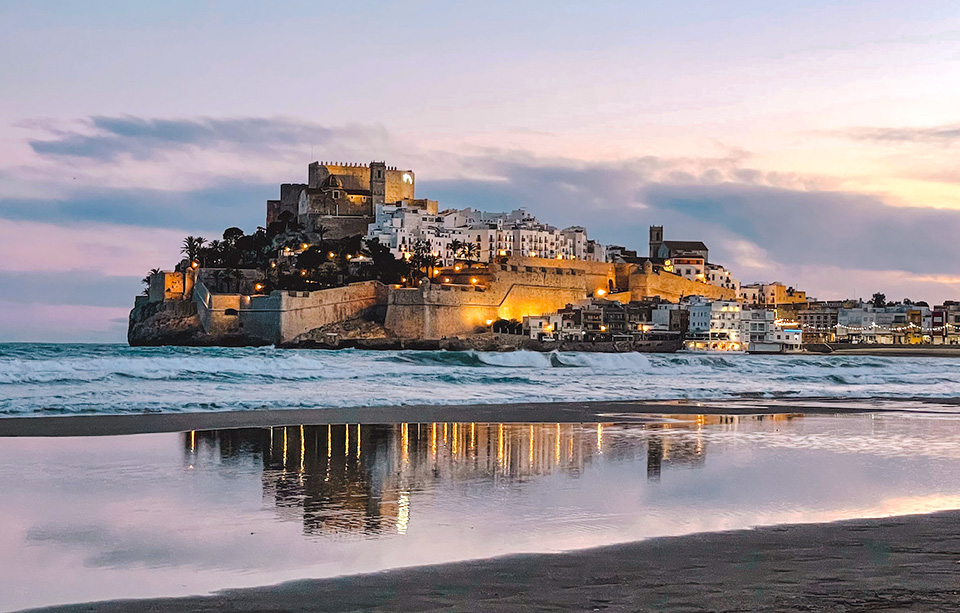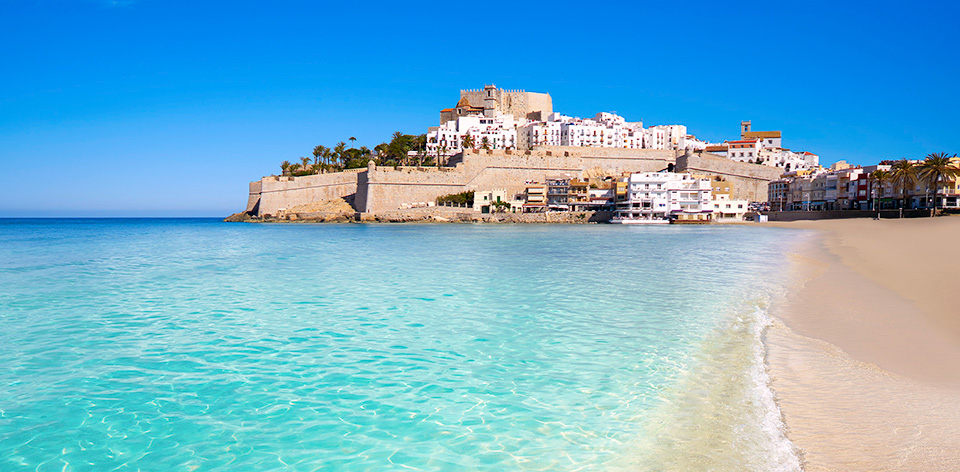The intense blue of the Mediterranean laps at the enormous rock on which the fortified city of Peñiscola proudly stands. Explore the Game of Thrones filming locations in Peñíscola on a day trip from Valencia. Discover one of Spain's best-preserved castles, crafted by the Templars.
A fairytale city, an almost magical place straight out of the movies, it is crowned by a Templar castle from which Pope Luna, Benedict XIII, drove the Western Schism and determined the fate of Christianity for many years. With its spectacular fortress, its steep narrow streets nestled within the city walls, its magnificent wetlands and golden beaches, Peñíscola offers visitors a wide range of surprising and beautiful urban and natural environments to explore.
The Fortress
The site of many historical convergences and divergences, Peñíscola has nevertheless remained a highly evocative place throughout the centuries. This Mediterranean city has perpetually been surrounded by fortified walls and the endless golden sands of its two beaches. With a providential abundance of natural springs, such as Dins, La Petxina and the Font de Sant Pere fountain, the inaccessible fortress shelters around 500 houses within its steep and winding mediaeval streets. The Sant Pere, el Portal Fosc and Santa María Gates open onto the bastion, known by the Romans as Pene Iscola (Almost an Island), as it is joined to the mainland by nothing more than a very thin stretch of land.
The main Sant Pere gateway leads to the fortress and consists of a low stone archway with the ancestral coat of arms of Pedro Martínez de Luna, (Pope Luna), carved into the lintel. It was Pope Luna who commissioned the construction of this gateway, to provide access to the sea.
From the Sant Pere Gateway, the street, Calle Las Atarazanas follows the line of the mediaeval wall around to El Bufador, a natural tunnel through which the sea flows, crashing noisily on stormy days. In Peñíscola, it is said that the Mediterranean breathes through this breach in the rock.
Museum of the Sea
The road continues around to El Baluarte del Príncipe bastion, where the old school building immortalised by the Spanish director Berlanga in his film Calabuig now houses the Museu de la Mar (Museum of the Sea) created to preserve and divulge Peñíscola’s maritime heritage.
From the museum, visitors can head into the heart of the city through its winding streets and secluded squares, past the whitewashed houses, many of which have been converted into charming restaurants and stores that hint at the city’s maritime history. From the lighthouse below the castle, visitors can marvel at how the sunshine glints off the ravaged, sea-swept stones that support the walls, and how it slips between the white houses.
El Baluarte del Príncipe bastion allows visitors access to the streets that climb up to the castle, where they can discover ancient nooks and crannies brimming with history. They can also try the extraordinary licor de kola alcoholic beverage made from the kola nut or the tisana del Papa Luna herbal tea, famous for saving the life of Pope Luna with its beneficial properties after he had been poisoned with arsenic.
Around the Castle
The lighthouse and the lighthouse keeper’s cottage mark the halfway point along the route. Precipitous, winding steps lead down from here to the sea. Now blocked off, legend has it that this stairway was constructed by Pope Luna in a single night.
After skirting the castle that figured so prominently in Anthony Mann’s film El Cid, the route returns to the white squares such as La Plaza de Armas and La Plaza de la Ermitana.
The Portal Fosc is a gateway attributed to Juan de Herrera that is built from white stone and adorned with military motifs. Leading to the guardhouse, the Portal Fosc was the main entrance to the city up until the 18th century and still bears the shield and cartouche of Felipe II to this day. The Portal Fosc leads straight onto the Town Hall Square which is dominated by the parochial church.
Constructed following the Reconquest, this church has a single nave and still boasts its Romanic facade. It houses jewels that belonged to Benedict XIII, such as the processional cross, a Gothic piece made of silver and rock crystal with carved images and the coat of arms of Pedro de Luna and the Pietà, and the Chalice of Pope Luna, made of gilded silver with limousine enamels. It also holds Clement VIII’s Lignum Crucis reliquary and Felipe II’s processional cross.
The Santa Maria Gateway
On the final leg of the route, still following the line of the medieval walls (some sections of which were built in the 18th century), visitors will pass by La Batería Alta del Maset, La Batería Alta del Boctoglio, La Batería Baja del Maset and El Polvorín in the Artillery Park, right where the Renaissance wall begins. The Baluarte de San Fernando, Baluarte de Santiago and Baluarte del Calvario bastions lead to the Batería del Olvido, or the Battery of Oblivion, so called as legend has it that French troops left a wounded soldier here by accident as they scaled the castle.
A little further on, after the Portal Fosc, the route leads to the Santa María gate.
The city route ends at this gateway, through which visitors can access the beaches and admire the vision of the fortified Peñíscola. Thanks to its history, to the silver screen and to the landscape which offers spectacular journeys between the Mediterranean and the Serra d’Irta mountains, this has become an eternal city.
The PRV-194 Trail
Visitors to Irta’s Natural Park will find many trails crisscrossing the mountains: beautiful yet arduous trails that cut through the rugged landscape that Peñíscola shares with Alcalà de Xivert and Santa Magdalena de Pulpis. Classified as of medium difficulty, the PRV-194 is a 26 km circular route which starts on the Sant Antoni Chapel path. The walk is expected to take six hours, rising to seven if a visit to the Pulpis Castle is included. The route also has three alternative trails enabling visitors to explore other parts of the range.
Constructed over five centuries ago, the Sant Antoni chapel has some rooms that are permanently open to the public, such as the chimney room, a circular hearth surrounded by stone benches set against the walls.
A path behind the chapel winds its way through the Avellanencs landscape and leads to a fork in the trail which branches off in two directions: one to Pulpis Castle, which was originally built by the Moors and has since passed through the hands of the Templars and the Order of Montesa, and the other, the main trail, proceeds to La Mallada de la Rabosa and from there on to Santa Magdalena de Pulpis, a distinctly Moorish town. After La Mallada, the trail drops down and follows the edge of the Carreres Gully, becoming a rather difficult cattle track before turning into a dirt track that leads to the Mas del Señor area, a leafy elm grove with a natural spring that is perfect as a resting place along the route.
The trail then continues along the same path, passing by Pou del Moro and leading to a traditional dry-stone cottage similar to the ancient Maestrazgo refuges on the Irta road. A track to the left leads down to the coast, to an unpaved section of the Pebret path, a cattle track that runs parallel to the coast.
On arrival at Pebret Beach, which is home to a small but magnificent sand dune ecosystem, visitors can explore the remains of an old police station that was in use until the 1950s.
From this point, the trail follows the coves and coastal outcrops until it reaches the Abadum Cliffs. Over 40 metres high, these cliffs are crowned by the Torre Badum Tower, used as a lookout against pirate raids.
From the Heights
The first alternative route on the PRV-194 trail starts at the Pitxells Gully. A signpost will direct you to a ramp leading to an old road used by cart drivers, with stone walls and the indelible imprints of the wheels ground into the earth. The trail then rises to El Corral de Baltasar, a dry-stone construction where the migrating flocks of merino sheep that grazed in Irta used to be sheltered over the winter.
The track then skirts a rainwater reservoir and leads to the abandoned farm at Vistahermosa before continuing through the mountains to Sant Antoni Chapel.
Along La Mola Hillside
This path is almost 20 kilometres long and avoids the highest part of the range. It starts one kilometre before Sant Antoni Chapel along a path that runs along the side of La Mola until it reaches a great dry-stone terrace. It then descends to Font Nova and continues to the Malaentrada Gully, which contains many remnants of traditional rural Mediterranean architecture. The trail comes to an end at a dirt track that leads to the Mas del Señor recreational area.
From Mas del Señor to Pebret
This alternative route leaves the recreational area and runs along both the heights of the range and the coast. From Mas del Señor, a dirt track leads to a turnoff and then continues on to the ridge that provides views of the Pebret Plain. The trail then runs past a group of ruins – possibly a mediaeval settlement – before dropping down to the coast, where it joins the Pebret path that leads straight to the beach.
Pope Luna's Fortress
Construction of Peñíscola Castle began in 1294, and its patrons, the enigmatic Templars, built it in the image and likeness of castles in the Holy Land. Sober, austere and ever encircled by the omnipresent Mediterranean, the fortress sits atop the highest part of the rocky crag that hosted the ancient city. Its days of greatest splendour were lived during the 12 years that it was Pope Luna’s refuge.
The castle underwent several refurbishments when Benedict XIII or Pope Luna set up residence there. On 21st July 1411, he arrived with several of his Cardinals and made the castle the third papal seat in history, after Rome and Avignon.
The life of Pope Luna was controversial and unusual: his was a remarkable existence, full of weird and wonderful events. Born Pedro Martínez de Luna at Illueca Castle in Zaragoza in 1328, he studied canon law at the University of Montpellier before becoming a teacher and devoting himself to the Church. He was appointed Cardinal and subsequently succeeded the first Pope of Avignon, Clement VII. At the Council of Pisa in 1409, unsuccessful efforts were made to get Pope Luna to renounce the Papacy. From this point onwards, his life and the life of Peñíscola were to be marked by several attempts to poison him and by the gradual desertion of his followers.
Benedict XIII took refuge in the castle, surrounding himself with the works of Ovid, Averroes, Petrarch, Saint Thomas and Seneca. It was here that he penned his treatises and concealed the Imperial Codex, an enigmatic parchment written by Emperor Constantine and kept in a gold tube that disappeared following his death and has yet to be found, despite the efforts of popes and kings to retrieve it.
Legend has it that Pope Luna was a miraculous man, and that one night he spread his cloak over the Mediterranean and walked to Rome with the help of his walking stick in order to declare to Martin V: “I am the true Pope”. It is also said that in a single night he built a staircase down to the sea, in order to flee in his galley, the Santa Ventura, once his followers had deserted him. That night, he lost his papal ring in the sea: an exceptional treasure that nobody has been able to find, as the sea has concealed the precious offering.
How to get there
By train: Benicarlo-Peñíscola Station (7km from Peñiscola)
By bus:
- From Cataluña, Aragón, Castellon, Valencia, Pais Vasco: Hife, phone: +34 902 119 814.
- From Madrid: Autores, phone: +34 902 020 999.
By taxi: Unión Radio Taxi Benicarlo Peñíscola, phone +34 964 46 05 06.
By plane: Manises Airport (Valencia): 150 km.
By car: Highway AP7 Exit 43
Peñiscola Map to download
You can download Peñiscola Tourist Map free from here. The map is available in PDF (901 Kb): Peñiscola Tourist Map
Peñiscola Location Map











